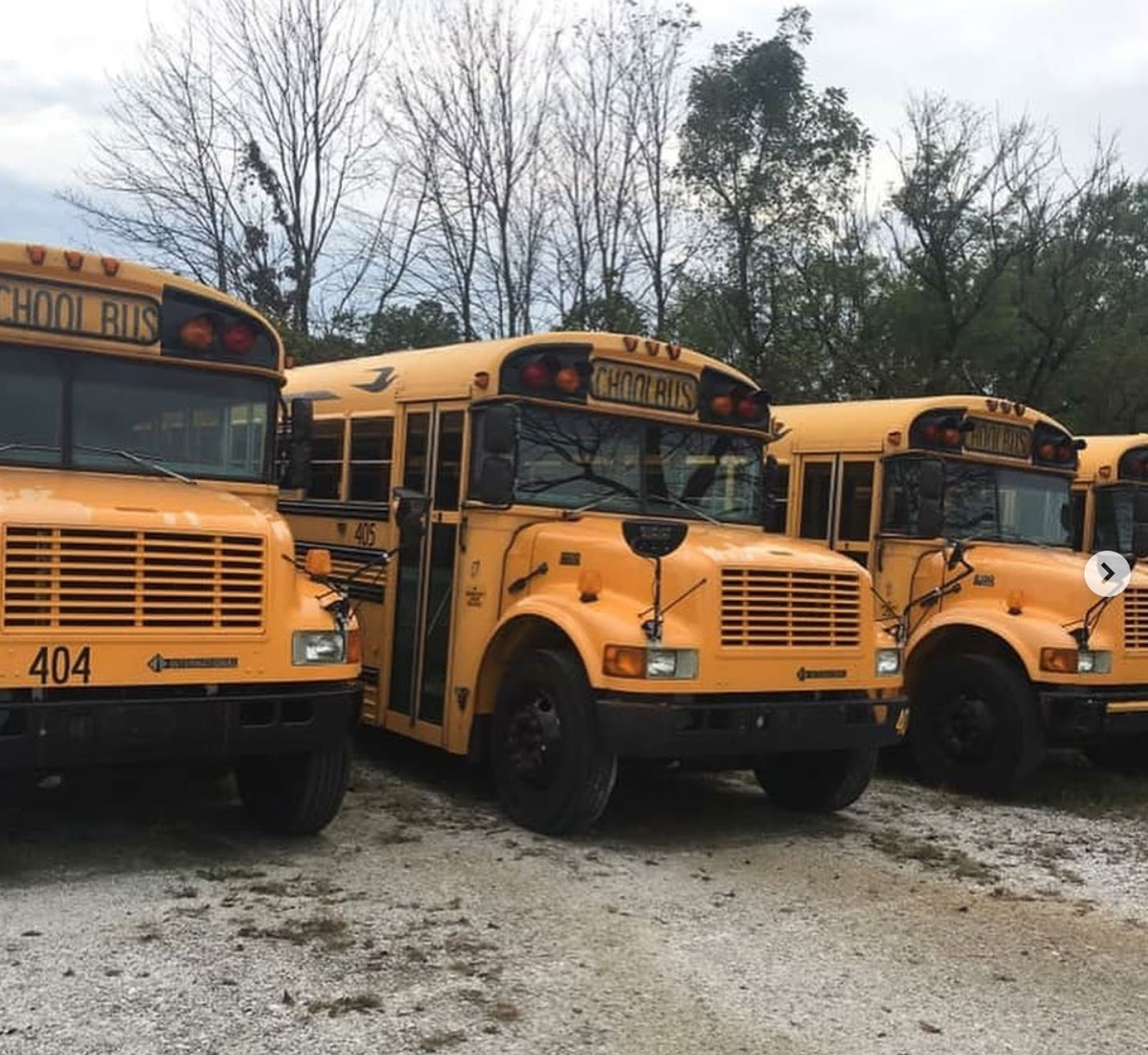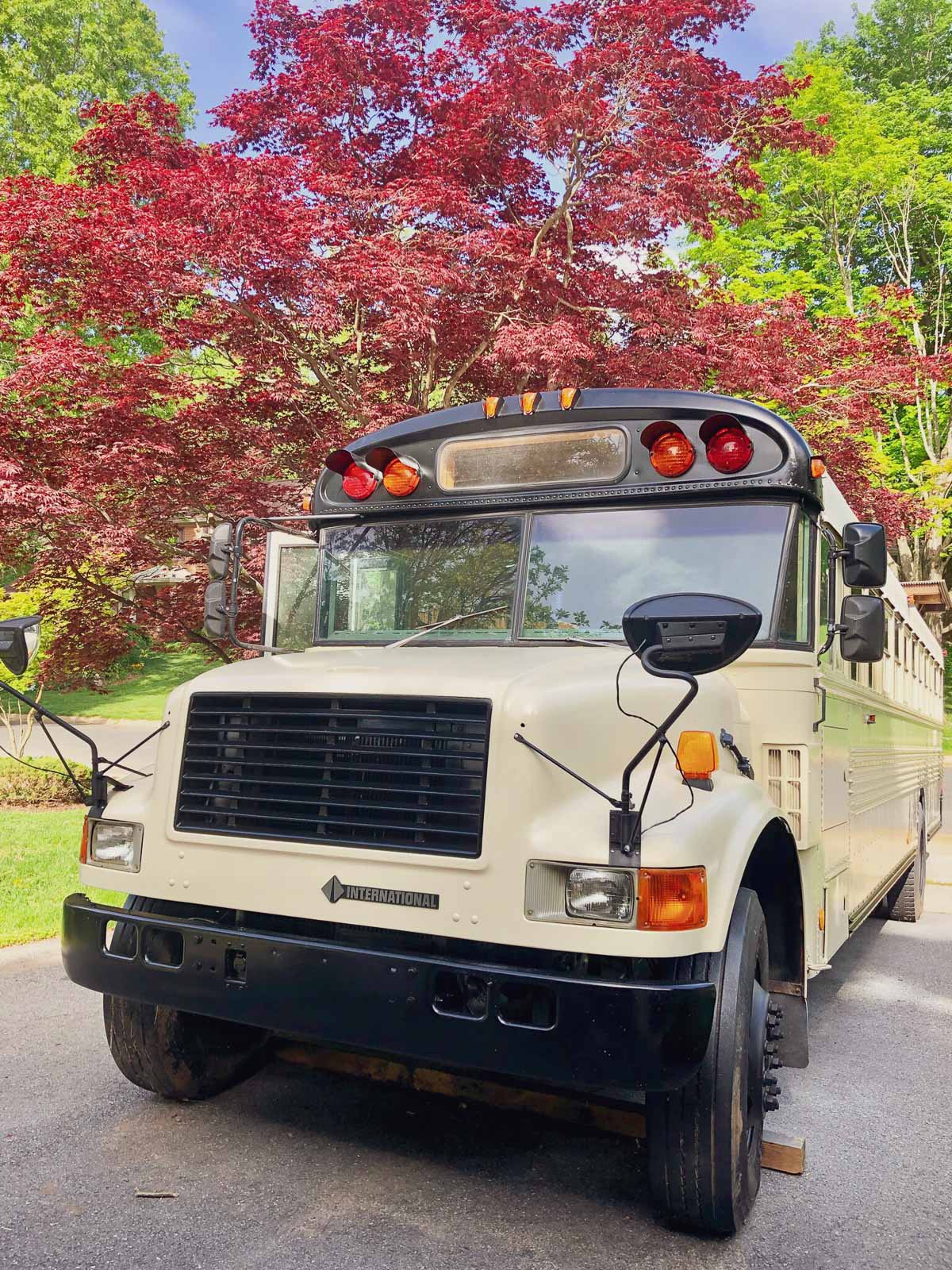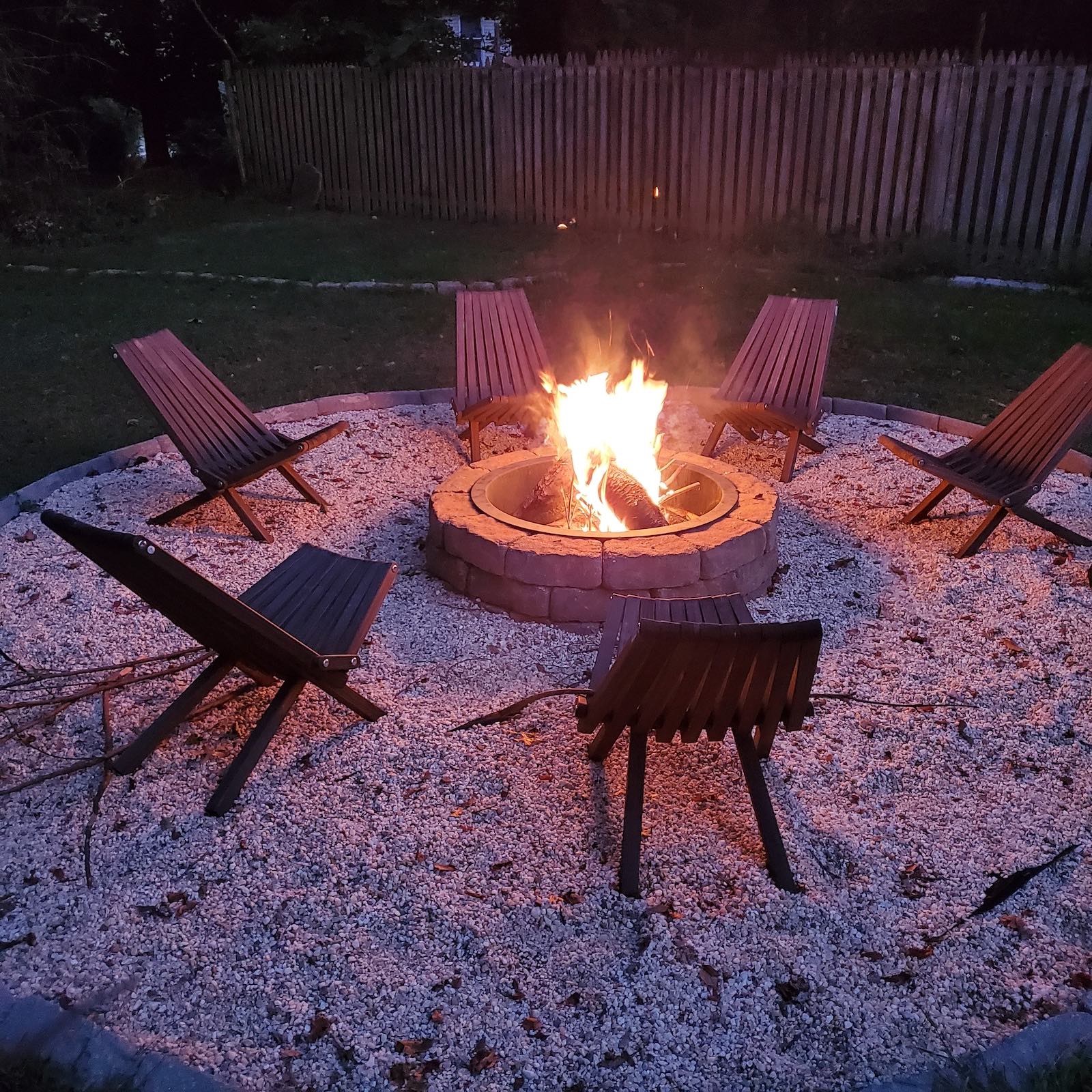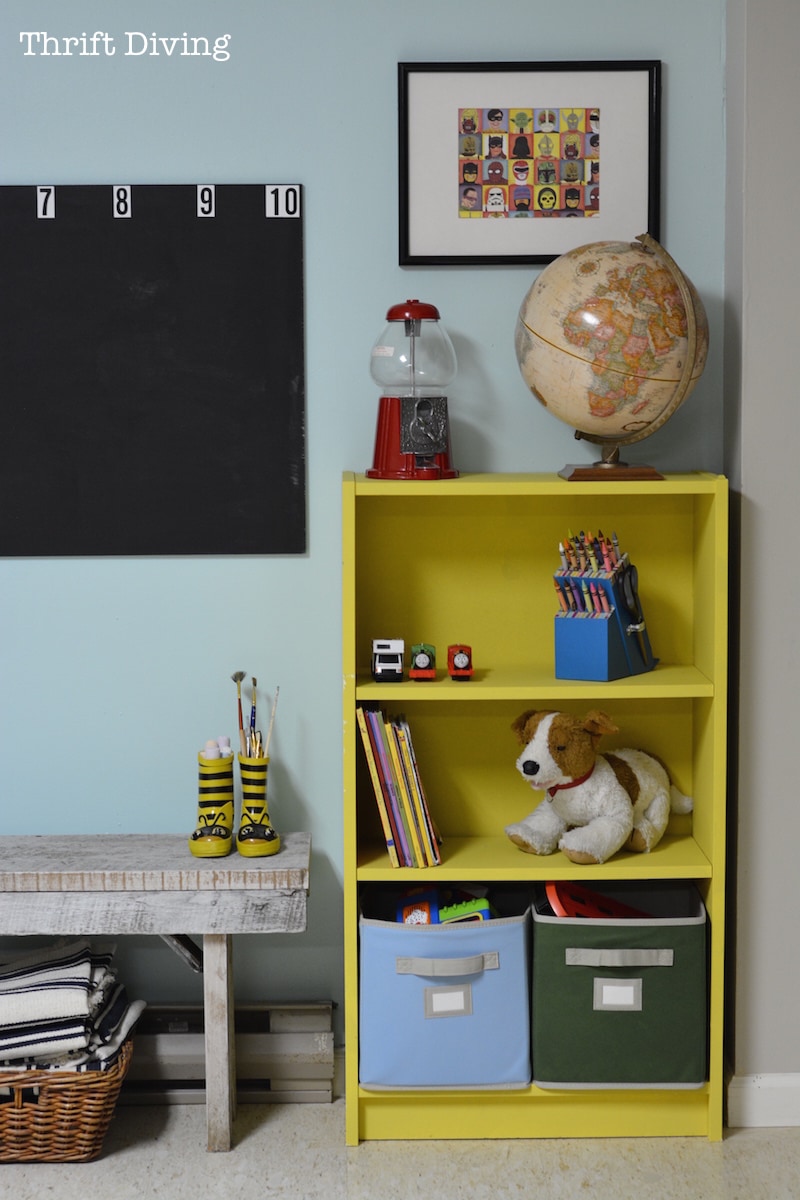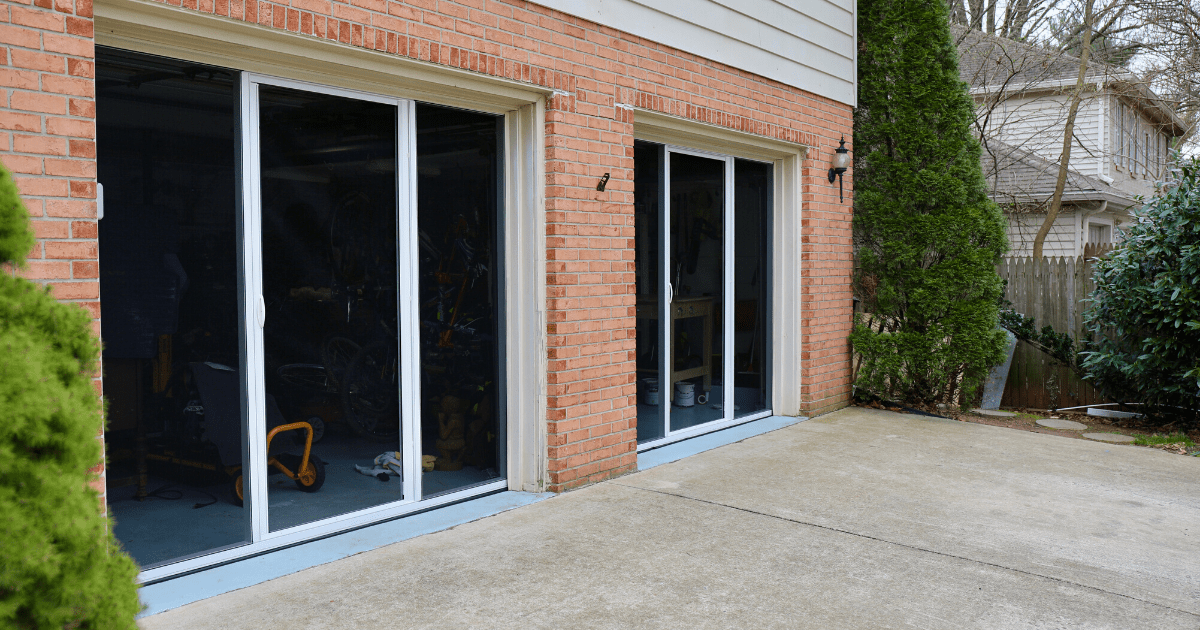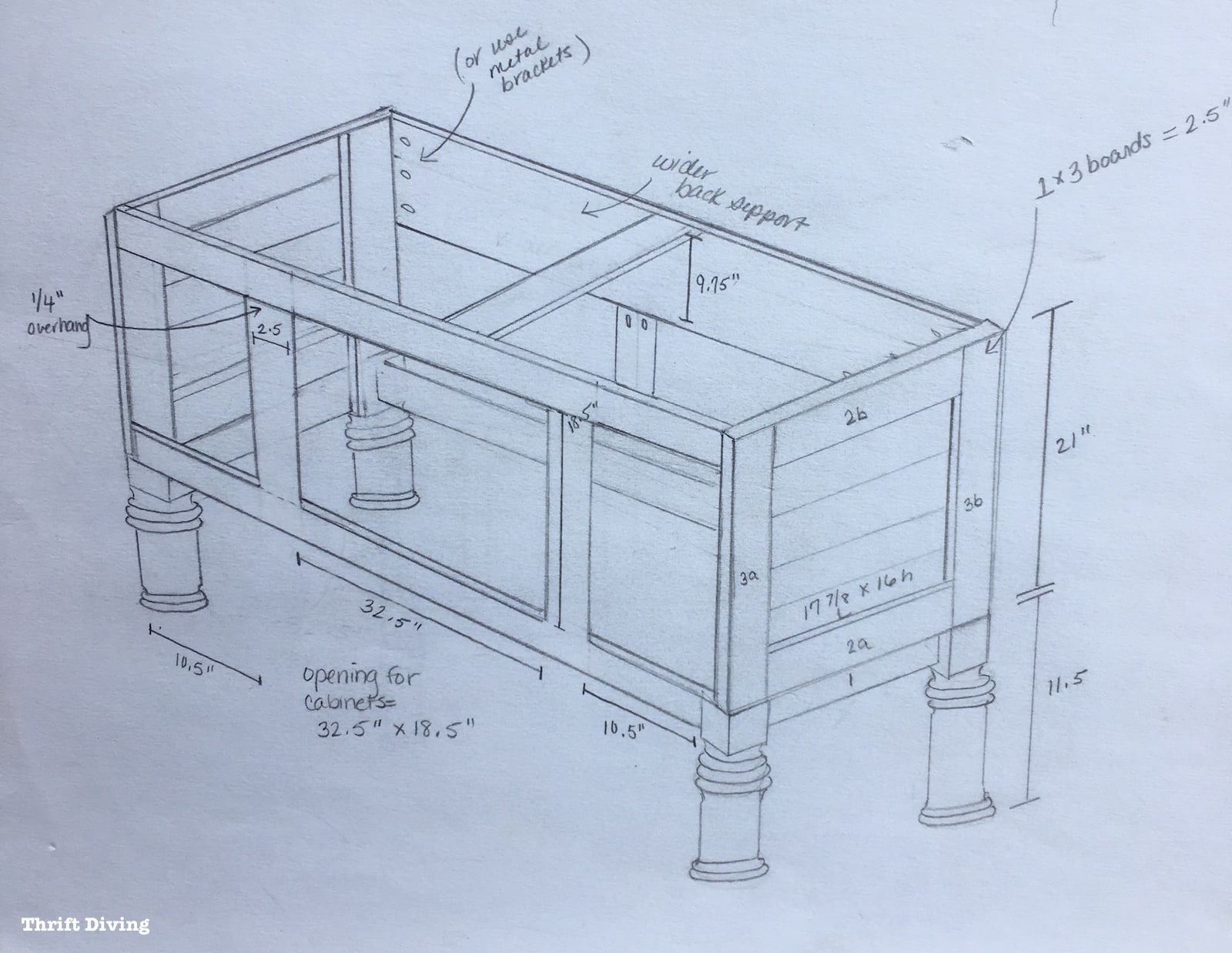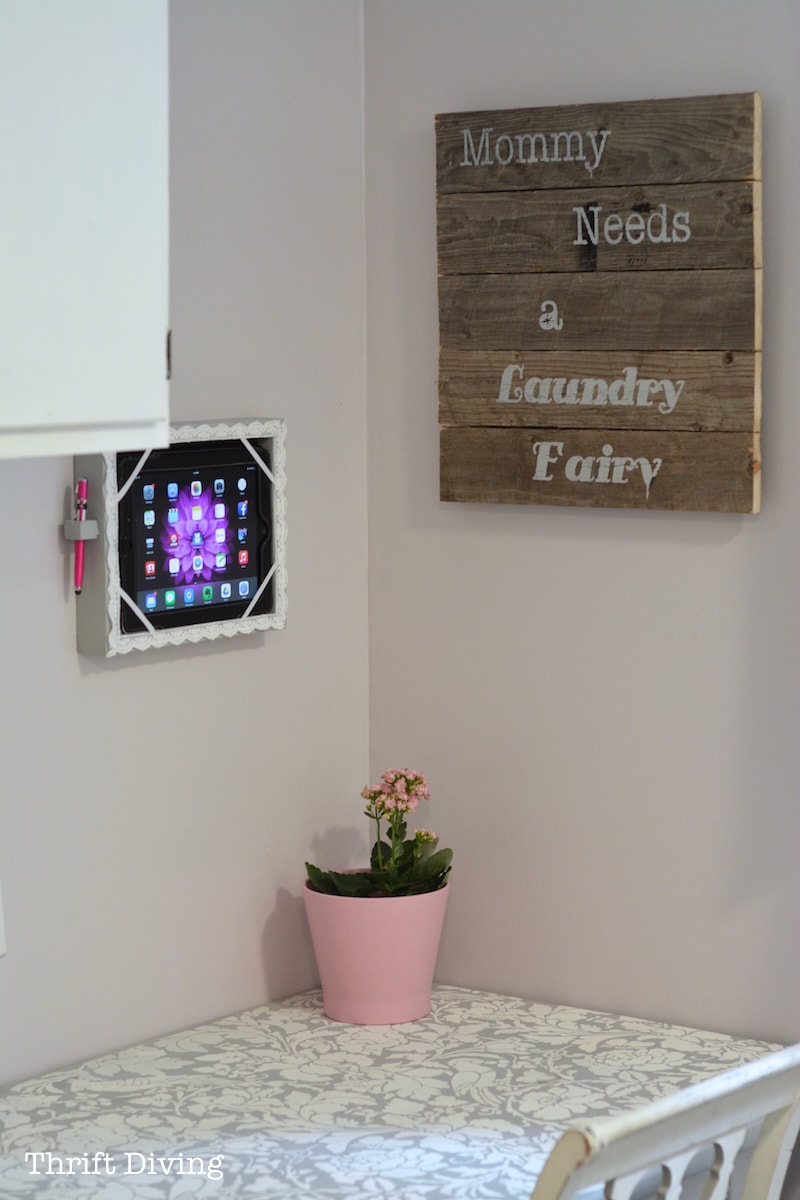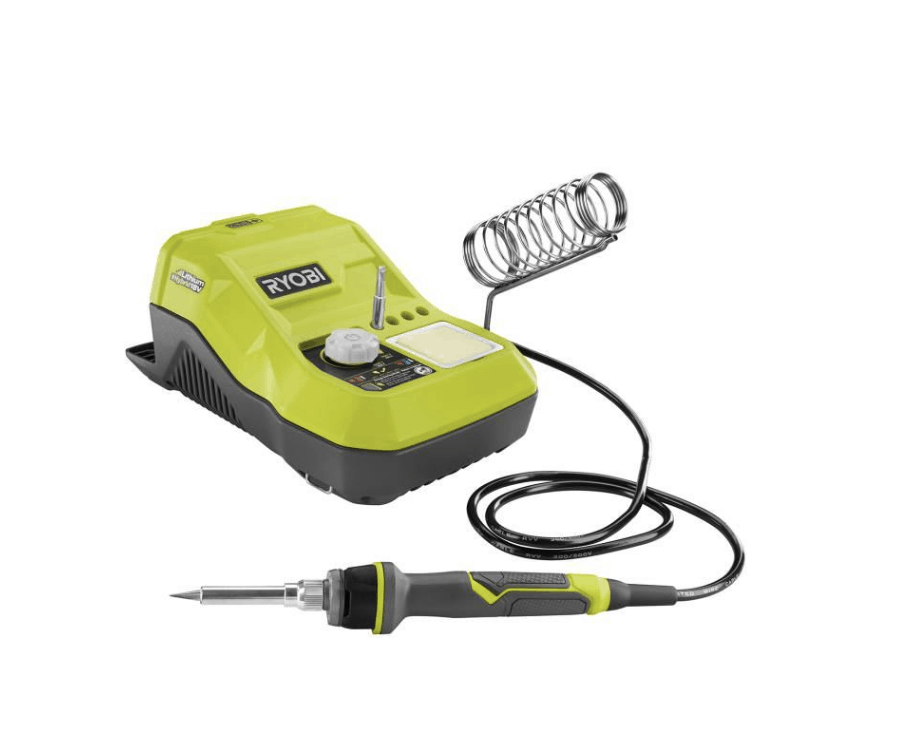This Skoolie Family Upcycled an Old Bus Into a Tiny House! (Episode 5)
In the summer of 2019, I had the opportunity to meet an awesome family that had turned an old school bus into a tiny house! (People who renovate school buses into tiny houses are referred to as “skoolies” in the skoolie community, I’ve learned.)
Surprisingly, they lived right down the street from me, across from my kids’ bus stop.
I remember waiting at the bus stop and seeing the top of a school bus peeking over the roof line of a home. In fact, there were two buses back there. (Of course, this was when the kids could actually go to school… Thanks, COVID. Insert extreme sarcasm here…)
BEFORE
I was so intrigued by what a huge bus would be doing in someone’s backyard, covered up with a blue tarp! So that summer of 2019, when my friend and I were out walking, we ran into who I would meet, Adam. He was diligently working on a pair of sawhorses. I didn’t want to intrude, but my friend insisted I stop to ask questions.
After an hour-long conversation, I knew that I wanted to share their story on Thrift Diving in one way or another! Look what they created!
AFTER!
For Episode 005 of The Thrift Diving Podcast, Chelsea, Adam and I had a chance to go in depth about their “skoolie” journey of renovating a school bus for their family to travel. We talked about their challenges and successes and lessons learned. This is a conversation that you don’t want to miss!
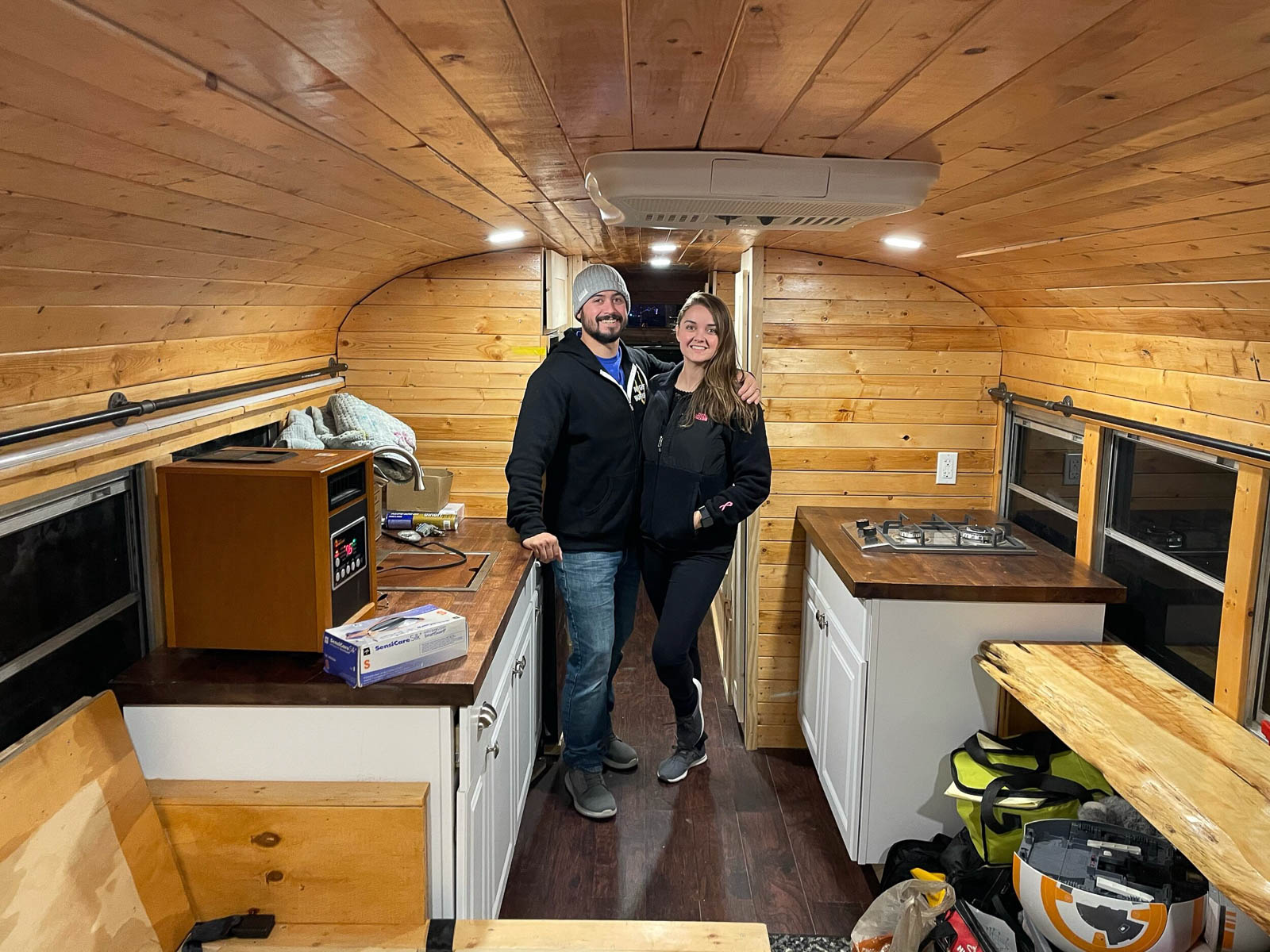
Listen to This Episode!
Be sure to follow along with Adam and Chelsea on their travel blog, Time to Go Adventure and on Instagram!
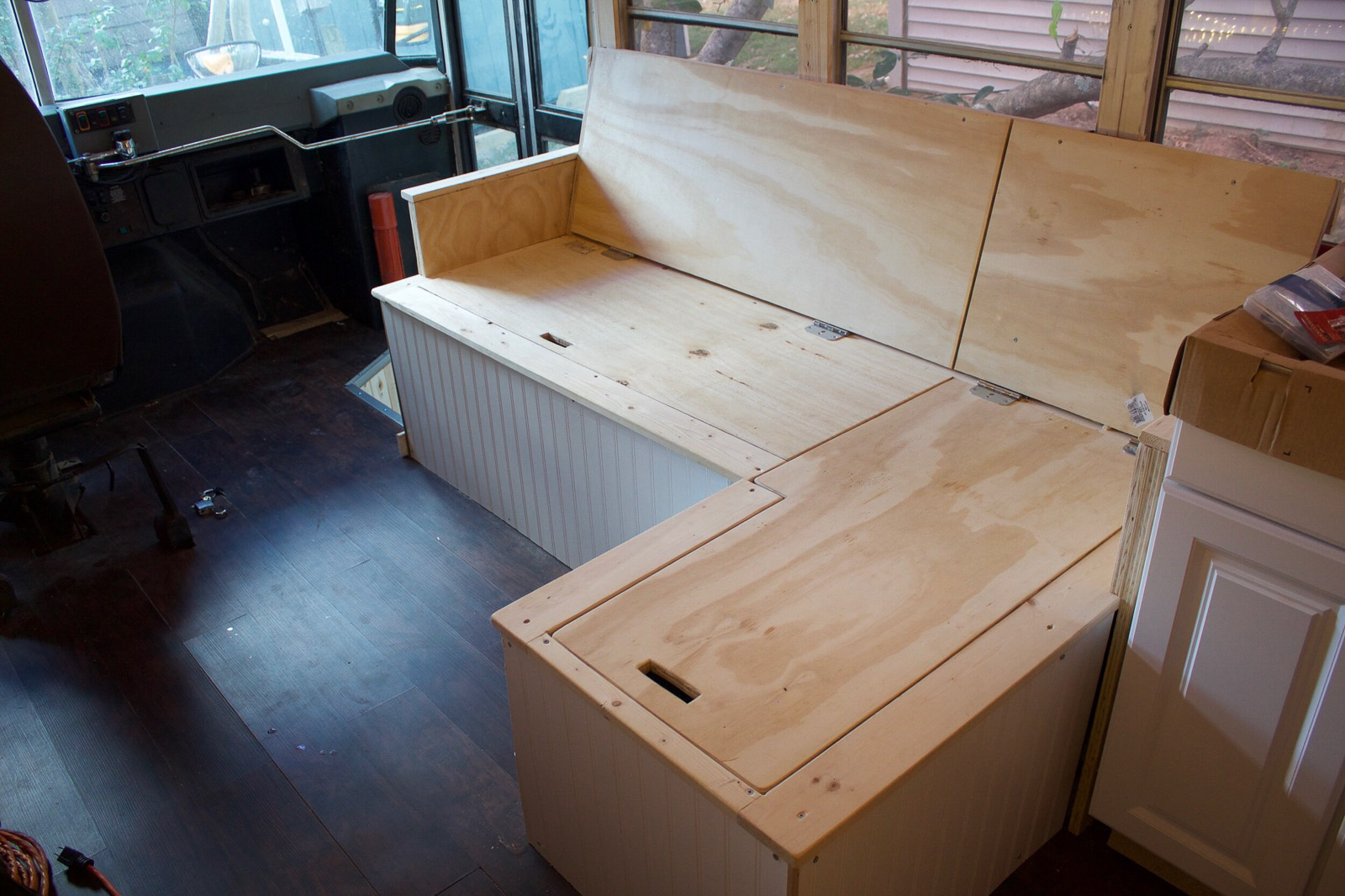
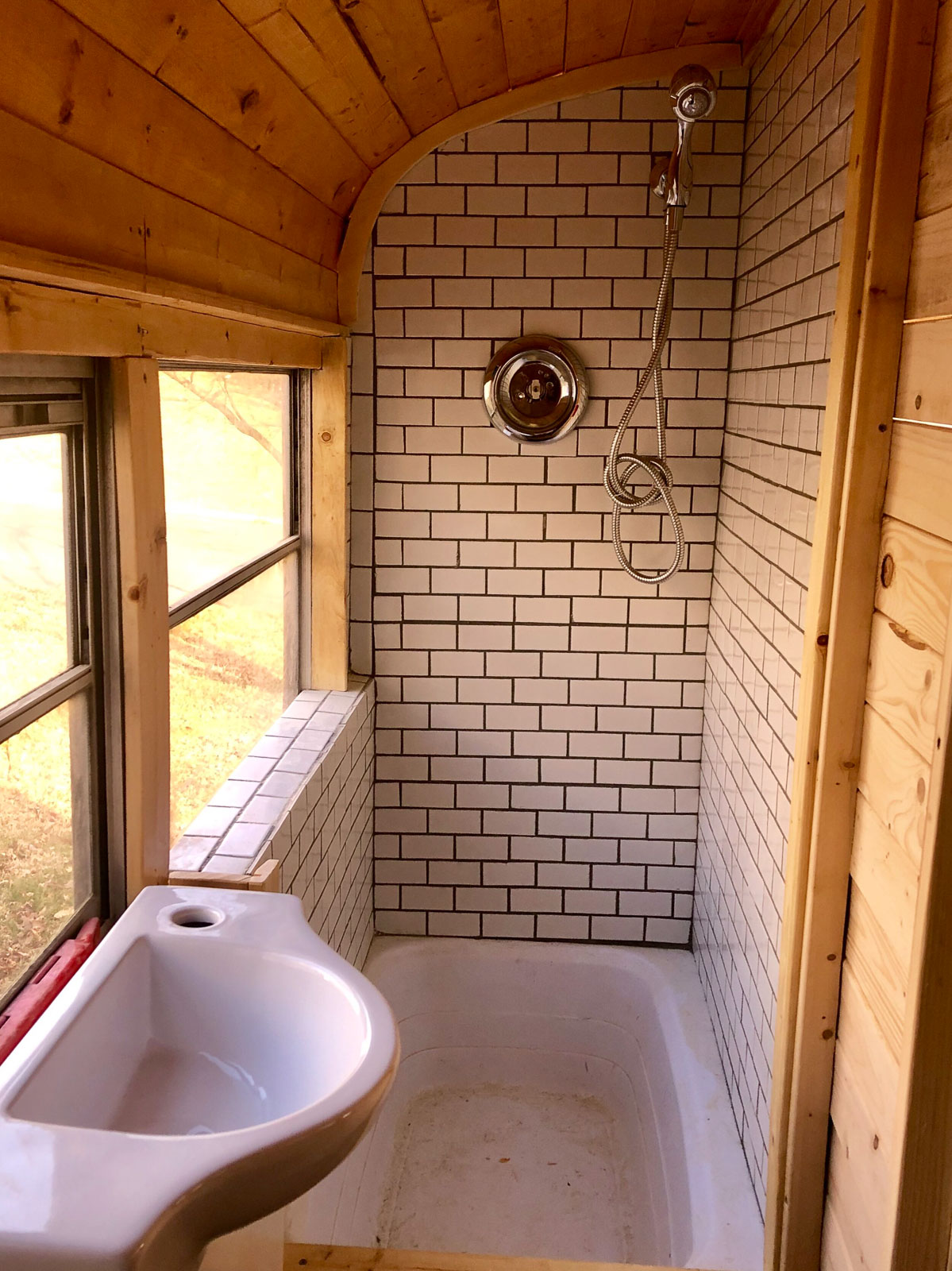
Show Notes
Curious about some of the things we talked about in this episode? Find these links below!
Time to Go Adventure Blog
Furring strips (used to line the ceiling and other areas of their bus)
Woodlawn Motor Coach – Where Adam and Chelsea purchased their bus. I’m not sure if this company sells buses right now or not, due to COVID.
Kokinda and Sons Saw Mill – Awesome place where live edge was purchased.
The Skoolie Nation Facebook Group – A Facebook resource for people interested in becoming or researching “bus life” or bus renovations.
Podcast Transcript
Serena: [00:00:00] So today I am so happy to be welcoming Chelsea and Adam Gibson. They are from Time To Go Adventure.
And we’re going to have a really cool conversation about how this family took an old school bus and started renovating this in their driveway and decided that they were going to do this, nights, weekends. And I’m so excited to welcome you guys. Thank you for coming to the Thrift Diving Podcast.
Adam: [00:00:23] Well, thank you for having us.
Serena: [00:00:25] So yes. Thank you, Chelsea. So it’s really funny. I just want to tell everyone how we met because you actually live in my neighborhood, which is, I mean, literally down the street, right across from my kids’ bus stop. Was it summer 2019 that I first met you?
And I was walking with my friend and I said, “There’s that school bus. And I think you, you were doing some work. You had your sawhorses out, Adam, and you were like in the thick of it. Cause it was a hot day. And you know, I didn’t want to interrupt you, but my friend’s like, “why don’t you go talk to them? Go talk to them!”
So it was her urging that sparked me to come over and talk to you. And you were working on this bus. So I wanted to find out from you and Chelsea, what has it been like owning this bus that you’ve been renovating? When did you get this idea that you wanted to join this community of people who are buying buses and renovating them?
Adam: [00:01:23] So we got our bus in November of 2018. And before that Chelsea’s sister lived with us and they had actually introduced the idea to us. They have a friend who made a bus and they traveled around the country and they really liked it. And at first when Chelsea and her sister brought it up, I wasn’t really too keen on the idea, but the more we looked at it and the more I really understood how customizable everything was, it totally grew on me.
Serena: [00:01:54] So when they first mentioned it to you, why were you not keen on the idea? Like, what about it turned you off? Not really turn you off, but why the hesitation?
Adam: [00:02:03] Driving a 35 foot school bus sounded terrifying.
I feel like I’m a good driver and I’m comfortable driving, but that’s a long, you know yeah.
Serena: [00:02:14] Got to watch those corners. You know, it’s funny that you mentioned that because today when I was looking up your site, and I just thought if I did something like that, how would I even drive it off the lot? Like, what are you– so funny that you mentioned that because I also have that same fear of thinking, How do you even dri–? Like, do they have to be specially trained in order to handle this? So what was that like getting the bus from– I guess, the Bus Depot or wherever. Where did you buy it from and how did you find it ?
Adam: [00:02:40] So we bought it from a company near Baltimore. And what they do is they take buses right out of the circulation from the schools. Cause once they reach so many years, they have to take them out of circulation for schools, just for safety reasons for the kids. So even though they’re in great shape, they take them out and get brand new ones.
And they’re– the company we bought it from, does that, and they sell, you know, school buses, they sell tour buses, the whole range of them. But we found them online and we had actually test drove a different school bus a couple of weeks prior in an empty parking lot. So it wasn’t our first first time, but–
Chelsea: [00:03:14] It was still really scary driving back home.
Adam: [00:03:18] Like the whole family was in the bus and we were like excited, but it was scary.
Serena: [00:03:24] What were you thinking Chelsea, when you decided– I mean, your sister brought this up. They had decided that they were going to do it too. What were you thinking? Were you like, Yeah, this is cool! Or did you have the same hesitations as Adam?
Chelsea: [00:03:35] I think I was hesitant at first, but I think it’s just the unknown, you know, I don’t know how to take seats out. I don’t know how to maintain a big school bus life. We’re going to live in, like, drive a school bus around the country? Sounded crazy to me.
But we’ve always loved to travel and show our kids new experiences and introduce them to new cultures that after we started talking about it more, because traveling so expensive, but like the ability to just have everything that we need. And we’re about to have our third child. So–
Serena: [00:04:05] Congratulations!
Chelsea: [00:04:08] But like paying for all of us to go on a vacation or for us to go camping now is even hard.
Shoving all three kids in the car. The two dogs, us that now having something, we can just shove everybody in and we’re all on the road and we’re going, it was– it just became so much more appealing, the more we talked about it, the more flexible we would have to just go travel.
Serena: [00:04:28] So what was that timeframe from when your sister-in-law had mentioned the idea to when you were like, You know what? Yeah, let’s do this. What was that timeline like?
Chelsea: [00:04:38] Not long, maybe a month.
Serena: [00:04:40] Oh my gosh. I remember when standing at the bus stop because your house is literally across from my kids’ bus stop. When we had school. That’s a whole other conversation. I missed that little corner. And I remember looking, seeing in your backyard, you could see this little poke of a bus, but I think at that time you had two, right? So did you buy the bus at the same time as your sister-in-law?
Yeah.
At the same time?
Adam: [00:05:05] Both of them at the same time. And then actually it got one of them stuck right there between our house and our neighbor’s house, getting it back there because it’s wide enough– it’ll fit, but the grass was so wet from the rain that we tried to drive it in at night.. Okay. We tried to like– we didn’t want it to be discreet about everything, but we drove it in at night and we had our neighbor’s permission to use her driveway and everything, but we got one– the front right wheel touched the grass and it sank immediately.
Serena: [00:05:34] Oh no!
Adam: [00:05:35] Six to eight inches. And then the rear left wheels were in the air. It was tilting, you know, towards our house. So, and of course it was 10: 30 at night. We’ve had one of our pickup trucks that we attach to a tow strap to the back of the bus and everybody pushed and I was reversing it and then we got it out.
Chelsea: [00:06:01] Our neighbors came out and they were like, Can we get the camera so we can record?
Serena: [00:06:05] Exactly!
Chelsea: [00:06:06] I was like, oh my gosh!
Serena: [00:06:08] You should have gotten a picture of that for the blog.
Adam: [00:06:11] That’s what we were just talking about, we could of have pictures when it got stuck.
Serena: [00:06:14] Exactly. So once you got the buses into your backyard, how soon after did you start working on it? Because when I was looking at your blog, which is Time To Go Adventures.com. Correct?
Adam: [00:06:25] Yep.
Serena: [00:06:25] Okay. So that’s your URL and everyone can visit there. There’s a timeline of amazing posts that really show how you got this bus, you didn’t have the picture of it getting stuck, but everything else is there, how you ripped everything out, you did insulation..
So how soon after did you just start working on it or did you leave it for awhile and, plan what you were going to do with this bus?
Adam: [00:06:46] I think because we knew there was a lot of demolition that had to take place, and a lot of taking stuff out, we got to work pretty quick, probably within a week, we had the seats out of both buses.
And we wanted to work on them together as a family. So we took all the seats out and the ceiling, all the old insulation, the floor, and we’ve got them all up to like a baseline level before we, chose whose bus was whose.
Serena: [00:07:11] Okay, so you just bought two buses. If you don’t mind my asking, do you feel comfortable sharing how much you paid for the buses? I’m just curious how much people could buy a bus for.
Adam: [00:07:20] Sure. So, and that’s funny because in an RV of this size is a hundred thousand easily. But– guess. I’d like you to guess how much are you?
Serena: [00:07:29] Oh my gosh. Let’s say. I don’t know, I don’t know, 10, 15, $15,000?
Adam: [00:07:36] $2,500.
Serena: [00:07:38] Are you freaking kidding me?
Adam: [00:07:40] 2002 school bus [inaudible]. So it’s got some mileage on it, but if they’re maintained, which they are, because you know, they have to transport kids all the time. They can last up to a million miles, so I’ve read.
Serena: [00:07:54] Oh my gosh! That is amazing! You know, I think people listening to this probably had no idea because I know that when I ran into you, I, I, I kind of knew that people did this, but I didn’t know that there was this whole community of people.
You told me what was the term that you used for people who were buying buses and renovating them?
Adam: [00:08:12] Skoolies
Serena: [00:08:13] Skoolie, right. I never heard that term before. In my phone, I actually have you listed as Adam – Schooley family. Cause that’s like, you know, I always put a reminder in there, so I can remember who’s who, and I had never heard of this.
So what kind of skills did you have? Because when I came up on you in that hot summer day, you had done a lot of work. I think you had had some wood– you did furring strips, right? You’d found those at Lowe’s. You did some furring strips. You had some work done. What was the level of your carpentry skills? Did you have to learn everything? Had you ever done anything related to carpentry before?
Adam: [00:08:49] So I took shop in like middle school years ago.
Serena: [00:08:53] Wait that’s– so that’s all we need is middle school shop. Okay, cool!
Chelsea: [00:08:57] If you want to have a really long process, because we’re still renovating the bus.
Adam: [00:09:02] But it’s all kind of learning as we go.
Chelsea: [00:09:05] Yeah.
Serena: [00:09:06] So if there’s something that you want to do, you pretty much just research it before you jump into it. And then you’re like, Let me figure out how to do this.
Adam: [00:09:13] Right. Right. And before we started the whole thing, as a family, we, made a PowerPoint and it was like a schedule of what has to happen. So everybody’s kind of on the same page, and if I miss something, she would think of something and vice versa, and then kind of went from there.
Serena: [00:09:26] What kind of time do you invest in this? Because I know you had told me during that summer conversation, when we first spoke that you would use like nights and weekends. I think you do some day. How much time do you spend working on this bus?
Adam: [00:09:39] Is “too much” an option?
Serena: [00:09:41] No, it’s never too much. It’s never too much because when you’re passionate about something, you can just, you’d be like, Look, who needs to eat or go to the bathroom? But realistically, how much time do you think you spend, per week working on this?
Chelsea: [00:09:56] And that’s such a hard question too, because, uh, you know, it all, it all depends on how much money you’re putting into the bus at the time and how much we have going on, or if we’re traveling somewhere or working. Cause you know, Adam stays home and he watches the kids during the day if I’m working, but we can’t be out in the bus cause our four year old’s not going to let us do anything.
Serena: [00:10:16] You know how kids are.
Adam: [00:10:17] Depending on the task, too.
Chelsea: [00:10:19] And depending on what we’re doing as well, but you know, some people have been able to completely renovate their busses from demolition to completion in less than six months.
We’re a year and a half into it. But I think, you know, on a good week, we’ll spend maybe 10 hours out there and then some weeks we get maybe an hour.
Adam: [00:10:38] And the weather too. The weather plays a big thing. Right now we’re painting. And if it’s rainy, we can’t do anything.
Serena: [00:10:44] And then Chelsea, you had mentioned you didn’t have like experienced doing a lot of things. But how have you grown from maybe not having a lot of, let’s say DIY skills to suddenly now– what are the things that you do to contribute to the bus?
I don’t know if it was you or your sister-in-law, but I saw somebody with an angle grinder, like cutting something off the bus and like, Wow. That’s like, that was so cool. So what do you do on the bus? I know you’re pregnant now, so that may limit some of the things that you can do, especially around chemicals and things, but what are the things that you like to do on the bus?
Chelsea: [00:11:16] I’ve just loved to get involved with all of it because I love learning new skills, but I had no, no experience whatsoever. I think I painted a dresser once and it was probably with somebody else. So I was probably just kind of more watching what they were doing.
Serena: [00:11:28] Right.
Chelsea: [00:11:29] But I may have gotten paint on my fingers or something. So I call it like I helped. Um, but I I’ve had no experience. So just being able to jump in and learn everything has been so much fun. So yeah, like the angle grinder, and it’s helped give you a lot of confidence as well. And you’re willing to just jump in there and learn and do these things because I like, that’s kind of scary as an angle grinder, is scary.
Serena: [00:11:52] Oh yes. The first time that I used an angle–, well, the first and only time that I used an angle grinder, I was putting new tile floor into my kids’ bathroom and it was the kind of tile– now, I didn’t realize I could have used tile snips. You know, here, I’m like pulling out these big tools and the chips are just flying at my face and I’m feeling like I need– I don’t know if that happened with you but, I felt like I needed a face shield or something to protect me because I’m like, this is scary.
You bring up a really good point. And this is something that I’m so passionate about when it comes to my audience, is that a lot of times people are afraid to get over that hump of, What if I mess up? Or, What if something goes wrong? How did you guys get past that fear of, “Oh my gosh, we’re doing something completely unknown.” What if we mess something up? How did you work through that?
Chelsea: [00:12:43] That’s a great question. I think mostly it’s, we don’t know what we’re doing anyway, so it’s– where we’ve messed up almost everything that we’d done had to take it out and redo it. So we’ve forgotten a step. And then, you know, we didn’t patch the roof well enough, so we put our ceiling up.
And then it rains and I’m like, Okay, let’s take it all down and find out where we have to patch the roof. And, insulation. We didn’t know anything about insulation. So we spent so much time researching stuff or watching YouTube videos and just learning so much about it, that we feel a small level of confidence going out there.
And then we realized, it’s also a bus, you know, we haven’t ton of money on it.
Adam: [00:13:21] Doesn’t have to be perfect.
Chelsea: [00:13:22] It’s not going to be perfect.
Serena: [00:13:24] Right.
Chelsea: [00:13:26] So we just go out there with the expectation, we’ll do it twice and it will be good.
Serena: [00:13:32] So what are some of the thrifty things that you feel that you’ve done in the bus that maybe you could have gone with something more expensive, but you were like, Nah, you know what– like for example, the furring strips on the ceiling. Furring strips for people that don’t know, but my experience is like when you’re doing crown molding, I’ve seen people use them and they’re just like, 1″ x 2″ boards.
And they’re very inexpensive and you can use them when you’re doing crown molding to help that crown molding stay up there. But, what kind of things did you make a decision, like, we’re not going to spend a lot of money on this. We’re going to do that instead. What are some of those things that you did that were more thrifty?
Adam: [00:14:08] I would’ve said furring strips, if you didn’t, because that would have been like our bread and butter. So a lot of people use shiplap for the roof or the ceiling. We went with the furring strips, but like the furring strips kept going. We’ve used them for walls, for some trim work along the couch.
The entire front and back of the bus inside. It’s a big panel with a little window in it. [Inaudible].
Chelsea: [00:14:33] Another thing, um, was the couch. We were so intimidated to build a couch because we knew we were gonna spend so much time and a lot of weight was going to go onto the couch, especially driving around, we weren’t sure. So we were like, maybe if we just buy a nice couch that has like some storage under it. We can install that somehow, but they were all a couple hundred dollars on the low end to a couple thousand and we ended up making our own couch and I just fell in love with it. It’s a nice, like L-shaped couch. It has so much storage in it and I just love it, that I’m so happy we ended up deciding, just try.
Serena: [00:15:07] Yeah.
Chelsea: [00:15:08] It’s so sturdy too, that I feel like if we’d gotten another couch, I would have been uncomfortable about it while we were driving. So, it was perfect. I loved it. Or, the live edge.
We wanted to get a live edge and put a live edge into the, into the bus.
And at first we were like, This is going to be the big expense that we spend, is buying this live edge. And it ended up being maybe 20 or how much was that–
Adam: [00:15:29] We paid for maybe 10 feet of board. We still have some leftover waiting for a project. It was about 50 bucks for the whole thing. And I trimmed it even for our live edge desk.
But a table that size with that finish, if you bought that off of, you know, Etsy or whatever, hundreds of dollars, and it was so easy.
Serena: [00:15:51] Where did you get that from?
Adam: [00:15:53] Uh, from a local mill. I’d have to look up the location. It was an hour from here towards Shenandoah, called Kokinda and Sons and their link is on our website. But they’re a great family, uh, really nice people, super interested in what we did with it too. We sent them pictures and–
Serena: [00:16:09] Oh, I’m sure they were happy to get your wood in that bus. So what are some of the– well, before I ask you about some of the lessons that you’ve learned along the way, how much do you– have you been keeping track of how much you’ve spent?
You paid about 2,500 for the bus, but in terms of how much money you’ve spent renovating the bus, have you kept track of that or are you just like whatever we have, we just kind of throw at it here and there, and we’re not really keeping track.
Adam: [00:16:32] Um, we’re not keeping track of everything, but, um, you know, we have a good idea of what each thing was. What stage, you know, like all the tile for the shower.
Chelsea: [00:16:44] I don’t think we’d gone over 6,000, including the cost of the bus so far.
Serena: [00:16:50] Oh, wow. That is awesome.
Chelsea: [00:16:52] We haven’t, bought like the electrical stuff yet, and I know that that’s going to be a big expense. So that’ll probably be like another, I would guess about another 1500 for that as well. But I think 6,000, including the purchase of the bus is a fair, probably on the high end. Yeah.
Serena: [00:17:09] That’s actually really affordable. And when you think about the cost of buying one of these huge RVs for a hundred thousand dollars, but now you’ve got this, this bus that you really can take anywhere and you don’t have to worry about the cost.
There was one thing that I saw in your blog that was very interesting. And you were talking about when you were making the selection or when anyone makes a selection, make sure you get the right bus. Because I didn’t realize there were like size constraints, like when you’re going to different parks, like national parks.
So can you talk a little bit more about that? How do people go about choosing a bus? Cause I know there’s different styles, but how do you make that decision? Like if I wanted to buy one, what would you tell me and my readers.
Adam: [00:17:49] So I’d asked you who was going to use it? If, you know, if it’s just a couple, they could go with a shorter bus. They don’t need 35 feet necessarily. And those are going to be easier to drive, easier to park, a lot quicker to renovate, stuff like that.
Serena: [00:18:06] You had mentioned the– oh gosh, what is it? Is it the dog nose? You bought a dog nose. So what’s the difference? So you’ve got the dog nose. Are there other types of buses?
Adam: [00:18:16] Yeah, so there’s the, flat noses and the dog noses, and we have the dog nose and that’s where the engine is in front of the whole bus. And even then there’s differences with the flat nose. There’s flat noses that have an engine like right under the driver, basically with a hump right there, or there’s a rear engine flat nose. And from what I researched, some are better at going uphill, you know, a pusher, I think it’s better going uphill than a polar or so, they call them, you know, depending on where the engine is.
Noise is also a variable. Ours is going to be a little bit quieter than a flat nosed engine up front because you know, there’s a whole firewall separating us from the engine.
Serena: [00:18:56] What would be the first step that you would recommend, like for someone who wants to do this?
Cause I can imagine that there’s going to be people listening to this, watching this, I’m already thinking about it. And I’m like, I don’t think my husband would be very happy with me pulling up, like pulling up one day. Hey honey, I’ve got a bus. He already complains about a lot of the projects that I do.
Um, but what would be some of the first steps that people that you would recommend people do if they’re going to do this, right? Like, I know you for example, like space, right? You have to have somewhere to park it. Your neighbor was nice to kind of let you go through, but what are some of the other things like upfront, make sure you do these five things or however many, what would you say people need to consider?
Adam: [00:19:37] So a couple of things you need to be willing to do your own research. You need to be willing to get your hands dirty. And you need to have patience because as with any project, there’s something that’s not going to go right, and you’re going to have to work around it or find your way through it–
Serena: [00:19:52] Or do it twice.
Adam: [00:19:53] Or do it twice.
Chelsea: [00:19:54] Three times, even.
Serena: [00:19:55] Three times.
Chelsea: [00:19:56] I’d make sure to check like the County codes as well. It’s that sometimes having a big bus or an RV alone in like the neighborhood, you’re not allowed to. So just making sure that you check your County codes, that you’re going to be able to park your bus where are you going to be working on it.
Another one is just, it’s like really having a minute to be able to really like make sure that you’re willing to put in the work because it’s hard work and it’s a lot of work. And I know there’s a lot of tasks that I would’ve had to go ask other people to help me with, like pulling down the actual panels in the ceilings, um, before we insulated everything because we pulled all of the original ceilings down and it was so much work and it was so manual labor that, you know, just making sure that you’re willing to take on that much effort upfront. Because you have to be really honest with yourself because that’s a lot of work and it’s a huge commitment. We’ve been doing it for almost a year now. Yeah.
Serena: [00:20:49] What are the communities, what are the resources or the places that you tend to check when you’re doing your research? I mean, of course there’s research on how to do certain things, but in the skoolie niche or community, who are those people if you say that name, everybody knows that person. They’re a good resource to learn more about doing this if someone wants to do that? Aside from you, of course, you know, people can follow your story.
Chelsea: [00:21:09] We don’t consider ourselves those people either. But I think it’s so, um, there’s so many different types of unique people getting in this community that I think it just depends on kind of what you want out of your build.
On Facebook, there’s like The Skoolie Nation, there’s like a hundred thousand people in that group alone, that that’s been a huge resource that if we can’t figure it out through Googling something or watching YouTube, is that there’s YouTube videos on there for everything.
Adam: [00:21:38] And there’s so many people on there that if you have a question, like I could be out there working and I come up with a question, I’ll post it. And within, you know, 10, 15 minutes, I might have an answer.
Serena: [00:21:49] That’s really helpful. Cause I’m sure there’s things that you, I mean, they come up all the time when you’re working. Like, I just don’t know how to do this. What do I do? So it’s good to have that community of people who have already been there, who know kind of what they’re doing.
I don’t know if you guys can forecast this, but how much time do you think you have left to complete this bus or you’ve not really like there’s no time constraint. It’s just whenever we get done, we get done?
Adam: [00:22:12] Well, we’re about to have our second son in about three weeks, so that’s definitely going to put a pause on things, but–
Serena: [00:22:18] Well, you know, they have baby carriers, and I can imagine Chelsea, maybe you just have the baby strapped on and you’re out there.
Chelsea: [00:22:26] [Inaudible] and I’ll be going.
I think realistically, if we could purchase everything. And so our next big project we’re going to be doing is the electrical work. And that makes me so nervous. So I’ve drafted up kind of the plans of how I think we should wire everything in and purchase everything.
And I just, we’re trying to find somebody to look over those plans for us. So then once I have like the warm and fuzzy that I’m not going to burn the bus down, I don’t think it’s going to take too much longer because we’re really kind of at the end, we’ve got the finishing touches, just like putting on cabinet doors and stuff, or we’re going to make like a nice sliding door for our bathroom.
And other than that, just doing the electrical work is almost the last thing that we have. I’m we’re just going to have to finish it up. So–
Adam: [00:23:09] I’d say maybe a year, if we kept going at a pace now, within a year, we’d be done.
Serena: [00:23:13] Awesome. At any point, did you guys think, Okay, I really don’t feel comfortable tackling this. We should maybe hire this part out. Did you feel that at any point and then how did you work through that and say, “You know what? No, no, honey, we can, we can do this. Let’s just keep going”?
Chelsea: [00:23:29] The whole time.
Adam: [00:23:31] The electrical, great example was the electrical, and we’ll touch on that when we get to the lessons learned, but I have no electrical knowledge other than I know it can kill you if you do it wrong. So that’s something I didn’t want to do. But she’s smart enough and has the drive to where she’s like, Oh, we can do that. So she’s done so much research. She could tell you a watt versus a volt versus a kilowatt, all that.
So she has our whole schematic electrical schematics drawn up and they’re waiting to be basically approved so we can, you know, buy the stuff and start putting it in.
Chelsea: [00:24:04] The only reason we did that is because we did reach out to electricians that– we reached out to a couple of them. We were like, Please come like tell us what this would cost and what– it was quotes up to $10,000.
Oh. The bus isn’t even worth that much. I haven’t even put that much money into the bus. I’m going to [inaudible] myself because–
Serena: [00:24:25] Yeah, that’s a lot of money.
Chelsea: [00:24:28] It’s a ton of money.
Serena: [00:24:29] Had you considered maybe taking a class? I don’t know if we had talked about this when I had seen you last summer, but I’m actually taking classes at Montgomery College, of course now, because of the Coronavirus, everything is online, which is definitely not the same experience.
But I was kind of like you, I was definitely afraid of electrical because it’s the thing that can kill you. It can start a fire if you don’t wire it properly. The carpentry program. Uh, I’ve done, uh, you know, framing and things like that, but one of the things I wanted to do was an electrical wiring class and I was this close to dropping it because I thought Wiring’s boring.
It’s well, it’s not boring, but it’s scary, but it’s, can’t really be that interesting other than the fact that it can kill you. And I found it to be so interesting figuring out how to wire something and how it was like a puzzle, right? Like how do you get the electricity from A to B, but it’s got to go through a switch first and then how do you do the little switch leg and go back to here?
So it was very interesting. So I did the introduction, the fundamentals class, and there were people in there who were not part of, uh, an electrical wiring program, some of them were just like continuing education students. you know, and then I loved it so much that I had started the other class, which was the residential wiring.
We were actually wiring the quote-unquote “building”, but it was like a two-level structure in the lab, but we ran all of our own wiring. Yes, all the way through every section and then the Corona virus hit. And so everything right before we could strip all the wires and connect them to the panel, everything got canceled and so we couldn’t finish.
So, that long story was just to say that if you did get to a point where you’re like, Okay, I think we know what we’re doing, but I really do want to get maybe a little bit more education, definitely consider, the community college, because you know, you can go in there and get your questions answered.
I mean, you’re paying for that teacher’s time and making sure that, okay, as you’re working on this, you’ll be able to have somebody to kind of bounce these ideas off of. So just an idea, just a suggestion.
Chelsea: [00:26:27] That’s a great idea. And I never would’ve thought of it. I would have just continued looking on YouTube.
Serena: [00:26:32] YouTube can work. I mean, I’m on YouTube. I fully believe in that, but sometimes the things and even my electrical wiring teacher had told me, You know, not everything that you see on YouTube is correct. And so if you kind of want to have a resource in your back pocket, definitely consider– I know there was one woman in the class who was taking it just as a non-credit course because she had old.
What is it? Um, Oh, I can’t think of it. It’s the old wire and tube. I can’t think of it, but anyway, it’s old wiring in her 1930s, 40’s home. She’s pulling all of it and read on it herself and she didn’t want to pay somebody to do that. Right. So she was using some of these fundamentals that she learned in this class or these two classes and doing it herself.
So if anything, it does make you a little less scared because then you’re like, Okay, I have a fundamentals of how this is all going to work and how to wire the switches. So just something to keep in mind.
Chelsea: [00:27:28] Yeah, no, I’m– definitely look into that. Yeah. That’s a great idea.
Serena: [00:27:33] As we wind it down, because I know we’re coming up here on our time. Also, I want to know, where are you guys planning to go? Like when you get this done, where is that first trip that you’re like, we’re definitely taking this trip.
Chelsea: [00:27:45] So the first trip, we’ll start there because I want to start with the good stuff. We want to take the bus and go up north through Canada. So go through like Nova Scotia and then go over did the British Columbia, hit Alaska and then come down the one through California.
Adam: [00:28:00] We have a book with all the national parks in it. And we have little 4 x 6, you know, snaps of us in those parks and the checklist and the very front of all the national parks in the country. So hopefully we can get some of those off our list.
Serena: [00:28:13] Oh, that is so cool. Oh, one other thing. You’ve been documenting this experience. How are you going to continue, like being a part of this niche of giving back, like, do you answer other people, like, let’s say if there’s someone who just gets into this, are you always going to be there as a resource? Cause now you’ve been done this for a year and a half. How are you going to continue to be a part of this community I should say of skoolie?
Adam: [00:28:34] Yeah. So whenever I see a question on any of those skoolie groups on Facebook, if it’s something that I know from experience or from reading, I don’t hesitate to help out, especially if it’s something that I’ve learned, you know, trial by fire. If I did it wrong and learn how to do it right, I’d like to maybe help somebody else, prevent them from doing it wrong.
Chelsea: [00:28:57] And then we get people, sometimes the pictures we put on Instagram, somebody would be like, Oh, we’re just about to start painting. Like what, what do you have? I would love to learn any in any like anything and everything that you’ve done with your bus so we can learn from you.
So we’ll get together with them over email or something and just kind of talk with them and talk them through our experience and how we’ve struggled through it and what we would do differently.
Serena: [00:29:21] So that is a good, that’s a good question. What would you do differently? That’s part of the lessons learned, but what would you do differently? Thinking back on this year and a half journey as we close things out, what would you do differently next time?
Adam: [00:29:36] I would do some of our, just the order of some of the things that we did, because it is like a small house, right. Because you’re going to live in it. It’s got electric, it’s got plumbing. It’s got furniture. We waited to do the electrical because–
Chelsea: [00:29:51] It’s scary.
Adam: [00:29:52] It’s scary. And we kind of, we found a way to make, we have tubes that run the length of the bus and they’re going to be like conduit for our wires. So we didn’t want to run our wires through the ceiling or anything like that. But I think if we could go back, I would do framing and then the electrical and plumbing together before doing the ceiling, before doing the walls, some of the furniture. Because now there’s times where we’ll have to take down a ceiling plank to run a wire or pull the fridge out, put it back in and stuff like that. It’s not like showstopper stuff, but it does cost time.
Serena: [00:30:28] Right, right. I could see that too. Just in my experience with carpentry, you know, as a carpentry student and doing some of the electrical things that we’ve done and the framing and typically in building. That’s a good point. That’s how things are done. You know, you have your electrical wiring people come in, you’ve got your plumbing people. And then you’ve got people that come in to do the dry wall and once everything’s in place and has passed code inspections and all that. So that’s a good one. So what are some other lessons learned? Things that you would pass on to someone else to say, “Hey, make sure you do this, or don’t forget!”
Chelsea: [00:31:00] One of the things is that we’re just finishing up the painting now and we– I don’t know what we did wrong, but I think it was just the tape. We taped off parts. Cause we were painting the trim black and when we went to take the tape off, I think we pulled it off too fast or we were pulling because it started pulling off some of the paint from the body and we need to go back and touch up little pieces there as well but, you know, just make sure you take it off slow don’t rip it off and–
Adam: [00:31:34] Again, not a showstopper, but if it could help.
Serena: [00:31:39] Yeah. I mean, you’re right. Those things do add up over time and especially if someone is on, I don’t know, it could be, someone’s on a tighter schedule where they’re like, Look, we’re going to buy this bus. We’re going to give ourselves a year. And if they kind of follow your model and say, Look, make sure you do the framing, the electrical and all of that, then you could save a lot of time. You won’t have to do a lot of rework.
So where can people find you? So I know that there’s people that are listening to this people who are watching this and they’re like, This is so cool. Where can they follow your adventure? On the blog and some other places where you’re posting updates?
Chelsea: [00:32:11] Yeah. So we have the Time To Go Adventure.com is our blog page. We’ve got Instagram, it’s Time To Go Adventure. And then Facebook, we’ve got a Facebook page as well that we try to keep up to date and it’s Time To Go Adventure, as well.
Adam: [00:32:24] We’re thinking about starting YouTube videos.
Serena: [00:32:28] Definitely. And I know we’re going to be talking after this a little bit about YouTube, because I think what you’re doing is so interesting that people just want to follow along and even as I was going through your page today, I mean, I, I worked backwards from most recent to the oldest and I was just intrigued every single time. But if I even had videos, like that would have been even cool, just even little snippets to see, like, how did they do that insulation in the bus? Cause that was pretty cool, right?
That red insulation on the floor. And then you had the insulation in the roof. I’d love to see little snippets of that. But of course, you know, that takes time. So if you think things take a long time now, add a camera, add some editing [long time], but it’s worth it. And it shares I think your experience in a way that, that people really get engaged in that may they will start to consider you like friends. Like they just want to see what’s Chelsea and Adam, doing this week?
Chelsea: [00:33:25] Nice way to put it.
I’ve been intimidated to get in front of the camera and like make videos. It’s always been so intimidating for me. So–
Serena: [00:33:32] Yeah. Well, I’ll walk you through that. It doesn’t have to be.
Chelsea: [00:33:36] Oh, good. Anything would be helpful. Cause even this, before our interview with you, I was like, this is so nerve wracking. I’m so scared. This is like the first time we’re going to be in front of the camera.
Serena: [00:33:45] Well, I’m glad that I could break you into the camera. See, now you’ve done your one interview. Now you can do your next video on just introducing people to who you are. I’ll give you some tips on that.
Okay. So we’re going to wrap this session up. This is Episode 5. All the show notes down below will have all the links that we’ve talked to. You’ll find links to Chelsea and Adam’s page, time To Go Adventure. And I’m Serena from thrift diving, and you can catch us next week, or you can catch us on the blog at Thriftdiving.com. And you can also find me on Thrift Diving on YouTube.
Loved This Episode? Check Out More Episodes!
Download the 5 freebies!

Thrift Diving inspires women to decorate, improve, and maintain their home themselves...using paint, power tools, and thrift stores! Use these 5 printables, checklists, and ebooks to get started!

